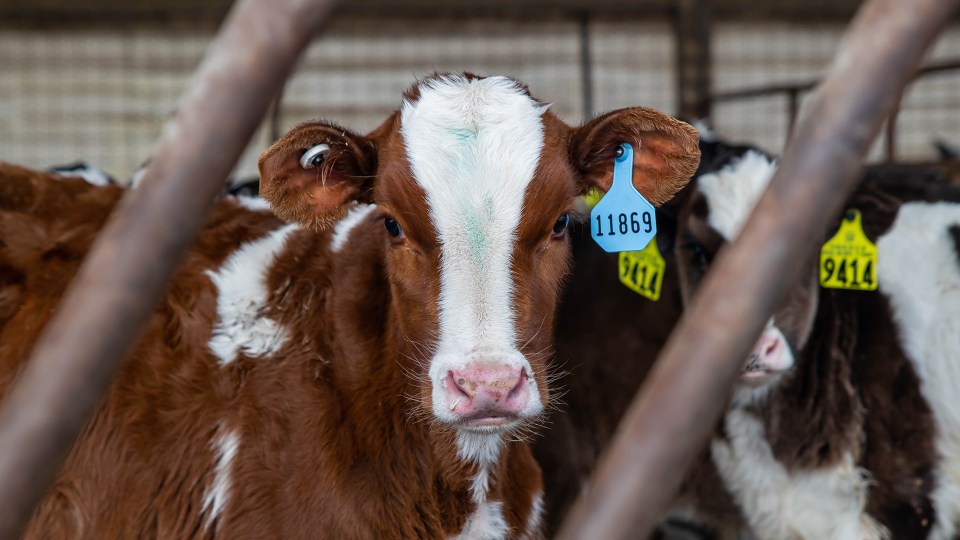Optimizing calf health for the move to group housing
By Dr. Tiago Tomazi
Calves are creatures of habit and any change in routine can be a stressful time for them. Moving from individual hutches to group housing potentially combines many stressors at once – new surroundings, feeding and watering changes, vaccinations, and socialization with other calves.
Stress can compromise a calf’s immune system and cause its body to mobilize fat and lose weight. Therefore, minimizing stress is a critical factor in raising healthy calves.

To help reduce stress, producers may want to consider limiting the number of new experiences for calves at one time. If changing pens, allow calves to adapt to their new environment before making a drastic change in diet. Adjust your schedule with your veterinarian to administer vaccinations or other actions at a time that’s less stressful for animals.
In addition to minimizing stress, it’s critical to provide quality nutrition; offer a clean, comfortable, well-ventilated and uncrowded environment; and effectively immunize calves at the right time for protection against diseases like bovine respiratory disease and scours.
Here are the best practices to optimize immune function and minimize disease risks to better prepare calves for the transition to group housing.
Consistent, quality nutrition
Calves need the right nutrients at the right time for optimum growth, health and temperature regulation. Since it’s typically easier to observe feed intake with individual housing, be sure to adjust your labor needs to monitor calf growth effectively in groups.
In terms of expected growth, the standard practice is to ensure >/= 1 lb average daily gain (ADG) in the first week of life,1 with a goal of doubling birth weight by 56 days of age.2
Digestive problems are a common challenge for young calves. To help reduce or prevent gastrointestinal issues, consistent feeding practices and proper rumen development are critical.
- Because calves prefer routine, significant variation in feeding practices can cause digestive issues or fatalities. Be consistent with feeding time and temperature, as well as percent solids in the milk replacer, to help prevent gastrointestinal issues.
- Calves need two to three weeks to develop their rumen in order to completely digest solid feed. Begin by providing a small amount (a handful) of starter, gradually increasing it as calves consume each day’s starter amount. When calves are eating at least two lbs of starter for two or three days in a row, they’re ready to be weaned.3
- A recent study showed that calves gradually weaned can experience a less dramatic change in average daily gain after weaning (1.83 vs. 0.49 lbs/day from day 49 to 54).4
Work with your nutritionist and veterinarian to evaluate your program and address any health or feed concerns.
Clean and comfortable environment
If calves are cold and wet, they need more energy to maintain their body temperature. On the other hand, warm and well-bedded calves can use their energy from colostrum, milk and grain to grow and develop.
- Stocking density for grouped calves is an important risk factor for illness and diarrhea. Research shows that calves with less than 3.28 ft2 have a 74% greater risk of developing diarrhea.5 Typically, grouped calves do better in smaller groups of six to nine animals,6 but this number can be increased in well-managed herds.
- Adequate ventilation in both cold and hot weather is critical for removing organisms and humidity from the air. Allow adequate air movement in warmer weather to decrease heat stress. In cooler weather, reduce the airflow to maintain the calves’ body temperature while ensuring sufficient fresh airflow to remove humidity and pathogens associated with respiratory diseases.
- Moist bedding can harbor pathogens and attract flies, especially in warmer weather. Bedding should always be clean and dry to provide less opportunity for pathogen growth as well as add comfort for the calf and serve as a barrier from the ground.
- Post-weaned heifers should have at least 35-40 square feet of bedded space, at least 12-18 inches of bunk space and at least 2-3 inches of water space.7
Effective immunization protocols
In pre-weaned dairy calves, diarrhea and calfhood pneumonia account for the bulk of health challenges, and respiratory disease accounts for almost half the deaths in post-weaned calves. When calves are healthy, comfortable in their environment and vaccinations are properly administered, they can be effectively immunized and prepared for the challenges of stress and harmful pathogens.
First and foremost, start fortifying the colostrum provided to calves with the specific antibodies against pathogenic organisms.
- Immunize late-gestation dry cows and replacement heifers with a scours vaccine to fortify colostrum with antigen-specific antibodies to help reduce diarrhea risks in neonatal calves. BOVILIS® GUARDIAN® is a scours vaccine with a flexible dosing window that offers the broadest spectrum of antigens associated with major bacterial and viral causes of scours in young calves. This includes rotavirus types G6 & G10, coronavirus types 1 & 3, Clostridium perfringens types C & D and Escherichia coli type K99.
Intranasal vaccines are administered directly into the calf’s nostrils, creating a mucosal immunity in the respiratory tract, which is functional and not interfered with by maternal antibodies from colostrum.8 Quality intranasal vaccines will begin to create protective immunity within three to four days after vaccination.9
- Administer an intranasal respiratory vaccine to newborn calves that includes protection against the most common respiratory viruses and bacteria. BOVILIS® NASALGEN® 3-PMH is the first and only intranasal BRD vaccine offering protection against IBR, BRSV, PI3, Pasteurella multocida and Mannheimia haemolytica.
- Bovine Coronavirus (BCV) is a major contributor to scours and can affect calves as young as one day of age. BOVILIS Coronavirus is the first and only intranasal vaccine for young calves proven to aid in the reduction of enteric disease caused by BCV.
Nutrition, comfort and immunization – all are fundamental in ensuring calves are healthy and able to meet the challenges of a group environment. If these three areas are not aligned, calves will have more health events and be less productive.
Talk to your veterinarian, nutritionist and animal health representative about your calf health protocols.
References
- Dr. Terri Ollivett, Department of Medical Sciences, University of Wisconsin-Madison School of Veterinary Medicine, presentation at the DCHA Annual Meeting, Minneapolis, Minnesota, 2022.
- Van Amburgh, Mike. What have we learned about calf nutrition and management over the last 10 years: A lot! American Association of Bovine Practitioner, 2009.
- Jones, C. M. & Heinrichs, J. Rumen Development, Don’t Wean Calves Without It! Penn State Extension. 2023. https://extension.psu.edu/rumen-development-dont-wean-calves-without-it.
- M. A. Steele, J. H. Doelman, L. N. Leal, F. Soberon, M. Carson & J. A. Metcalf. Abrupt weaning reduces postweaning growth and is associated with alterations in gastrointestinal markers of development in dairy calves fed an elevated plane of nutrition during the preweaning period. J. Dairy Sci. 2017. 100:5390-5399.
- Bendali, F., Sanaa, M., Bichet, H. & Schelcher, F. Risk factors associated with diarrhea in newborn calves. Vet. Res. 1999. 30, 509‐522.
- Svensson, C. & Liberg, P. The effect of group size on health and growth rate of Swedish dairy calves housed in pens with automatic milk‐feeders. Preventive Veterinary Medicine. 2006. 73, 43‐53.
- Cornell Cooperative Extension Southwest New York Dairy, Livestock & Field Crops Program. https://swnydlfc.cce.cornell.edu/submission.php?id=1491&crumb=dairy%7C1.
- Osman, R., Malmuthuge, N., Gonzalez-Cano, P., Griebel, P. Development and Function of the Mucosal Immune System in the Upper Respiratory Tract of Neonatal Calves. Annual Review of Animal Biosciences. 2018.
- Kesl, L., Saltsman, R., Burdett, B., Nordstrom, S., Xue, W. Determination of the Number of Days from Vaccination to Challenge Required for Protection from Infectious Bovine Rhinotracheitis (IBR) Virus Challenge Following Vaccination with Onset 5 IN and Vista 5 SQ in 13–30 Day Old Colostrum Deprived Calves. Publication pending. World Buiatrics. 2022.
Find more content for your dairy operation.
About the author

Tiago Tomazi, D.V.M., Ph.D.
Dairy, Technical Services,
Merck Animal Health
